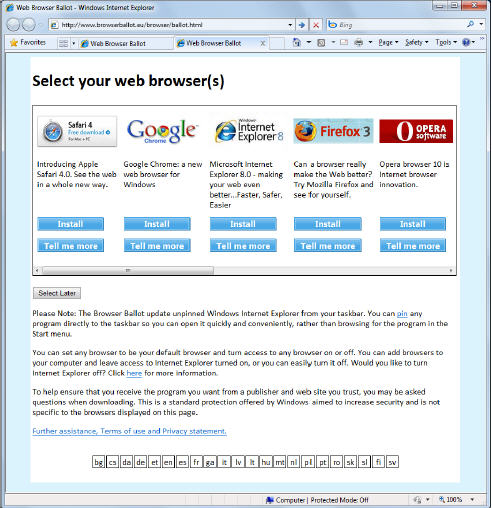Microsoft makes changes to browser ballot screen; user testing to commence

Microsoft is making changes to the ballot screen that it proposed to the European Commission (EC) as a way to ensure more browser choice on Windows PCs.
The company announced on October 7 details of the planned changes, and EC regulators said they'd begin testing those changes among European consumers. Here's a screen shot of the newly modified ballot screen:
The inclusion of a ballot screen -- which will be delivered to XP, Vista and Windows 7 PC users in Europe via Microsoft's Windows Update patching mechanism -- is one of the concessions Microsoft made to try to appease the European antitrust regulators in their investigation of Microsoft's practice of bundling Internet Explorer (IE) with Windows. The investigation was the result of an antitrust suit brought against Microsoft in 2007 by Opera Software.
Microsoft revealed its initial ballot screen proposal in July of this year. On Wednesday, Microsoft officials said they'd modify this screen to make it more palatable to regulators and its competitors, a number of whom have said the proposed screen fell short of the mark. In addition to providing an initial screen that describes what a browser is and to verify a user is connected to the Internet, the second actual ballot screen under the new proposal includes several modifications. These include changes to:
- Make it so competing browsers can be downloaded from the ballot screen more quickly and easily
- Ensure equivalent placement on the Windows 7 taskbar for Internet Explorer and all other browser icons
- Add introductory information, improving the design of the ballot page about each browser to help users make more informed choices
- Alphabetize the list of browsers so that the five most popular are listed first (by vendor), followed by the next seven most popular (also alphabetically ordered), so that 12 choices are displayed in total
- Provide the browser ballot to users for five years
Microsoft officials said they are planning to use Windows Update to push the browser ballot to Windows PCs, including Windows 7 machines which go on sale on October 22, so as not to require PC makers to preload anything additional on new machines. Under Microsoft's proposal, PC makers also will be free to bundle browsers other than IE on new machines, as well as turn off IE all together.
Microsoft officials also pledged on October 7 to do more to share interoperability information regarding Windows, Windows Server, Office, Exchange and SharePoint with other software makers. The company also said it would address security software vendors' concerns by disclosing "certain programming interfaces addressed by Microsoft's own security products."
Microsoft agreed to provide Windows users a choice of browser via the so-called “ballot screen” option — something the Commission originally advocated — as part of its settlement talks with the EC. Microsoft originally was dead-set against the ballot screen option; officials said the company would rather ship Windows 7 with no browser included at all than to ship one with a ballot screen. Microsoft scrapped plans for a browser-less Windows 7E earlier this year.
The EC still has yet to issue its final findings, remedies and fines (if any) in the Opera antitrust case.
The EC is giving interested parties a month to comment on Microsoft's updated browser ballot proposal. What's your two cents? Is the modified browser ballot going to help consumers make more informed choices?
